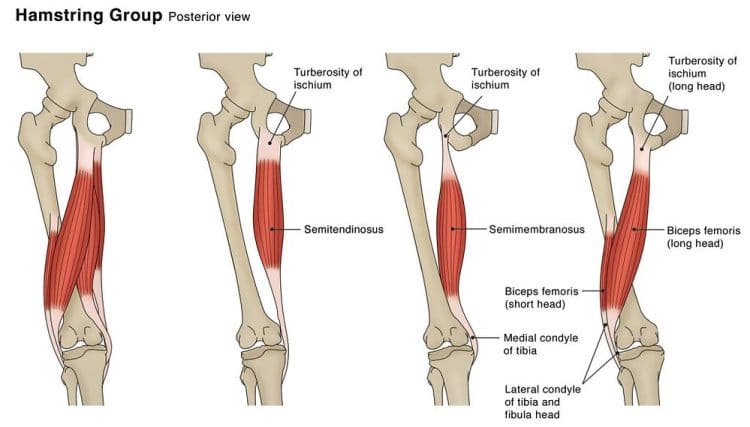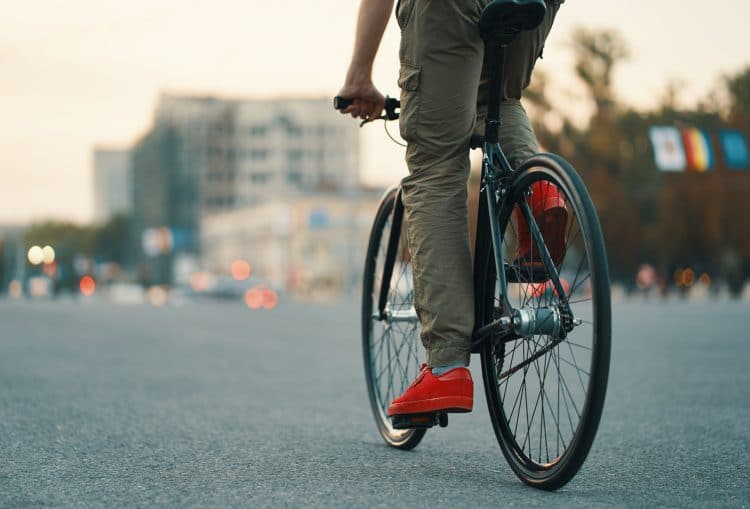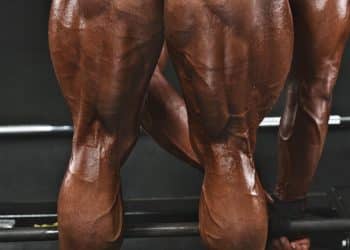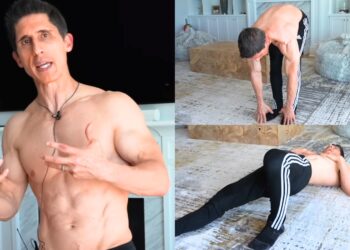The hamstrings are a large, powerful group of muscles located on the back of your hip and thigh. They are biarticular, which means they cross two joints – the knee joint and the hip joint.
There are three muscles that make up the hamstrings:
- Biceps femoris
- Semimembranosus
- Semitendinosus
These muscles work together to flex (bend) your knees and extend your hip. As such, they’re involved in a wide range of activities, including running, jumping, and lifting objects off the floor, i.e., deadlifts.
Unfortunately, tight hamstrings are common and can cause several problems.
For example, if your hammies are tight, you won’t be able to lean forward (hip hinge) without rounding your lower back.
Level Up Your Fitness: Join our 💪 strong community in Fitness Volt Newsletter. Get daily inspiration, expert-backed workouts, nutrition tips, the latest in strength sports, and the support you need to reach your goals. Subscribe for free!
A rounded lower back is a weak lower back. That’s because the stress that should be supported by your erector spinae muscles ends up being borne by the intervertebral discs and ligaments. These passive structures are easily injured and slow to heal.
So, if you can’t help but round your back at the bottom of squats or when doing kettlebell swings or Romanian deadlifts, tight hamstrings are probably to blame. However, a weak core and lifting too much weight could also be contributing factors. If lifting less weight doesn’t make a cure the problem, it’s your hammies that are tight.
Tight hamstrings can also limit your range of motion so that if you try and move beyond that range, you end up pulling and injuring a muscle.
For example, if you kick a soccer ball, you may feel a pulling sensation in the back of your thigh as your leg swings upward. Tight hamstrings are very susceptible to injury.
While you don’t need the flexibility of a gymnast (unless you are a gymnast, of course!), you should be able to hip hinge without rounding your lower back.
In this article, we reveal five ways to fix tight hamstrings.
Common Causes of Tight Hamstrings
Before we get into the methods you can use to relieve your tight hammies, let’s take a moment to investigate what makes them tight in the first place.
In fact, you are probably doing something right now that is responsible for most incidences of hamstring tightness…
Sitting in a chair with your legs bent puts your hamstrings in a shortened position. The longer you spend sitting each day, the more likely you are to have tight hamstrings. That’s because your body is highly adaptive and gets better at dealing with whatever you ask it to do.
When you sit, your knees are bent, so your hamstrings are in a shortened, semi-contracted position. As your body gets used to this position, it makes adaptations so that this position is easier to maintain, and that includes shortening your hamstrings. Your hip flexors and abs also shorten, while your erector spinae muscles tend to lengthen.
Prolonged sitting is often hard to avoid, especially if you have a desk job. However, many people make this problem worse by sitting during exercise, such as while using a chest press machine, sitting for leisure, and doing other activities where the hamstrings are placed in a shortened position.
Given how long most people spend with their knees bent per day, it’s hardly surprising that tight hamstrings are such a widespread problem.
Repetitive, short range of motion activities can also increase hamstring tightness. For example, running and cycling involve the hamstrings, but the hips and knees are seldom fully extended. As such, the hamstrings are always in a shortened position.
Your body operates on a system of “use it or lose it.” If you never take your hamstrings through an extended range of motion, invariably, they will shorten and tighten.
In some cases, tight hamstrings are the result of muscle weakness. For example, suppose your glutes are weak. In that case, your hammies may tighten up because they’re being forced to work harder than usual to support your underpowered butt. The hamstrings themselves may also be weak.
The good news is that muscle weakness is easy to fix. Just hit the gym and start lifting progressively heavier weights. For this reason, posterior chain training should be part of everybody’s workout.
There are also several ways to restore lost hamstring flexibility and alleviate hamstring tightness.
How to Fix Tight Hamstrings
If you can’t hinge forward from your hips without rounding your lower back, you may have tight hamstrings. However, most people should be able to achieve roughly 90 degrees of hip flexion before their lower backs start to round.
So, lie on your back with your knees straight and ask a partner to raise one leg up. If you can’t reach 90-degrees, your hammies need some attention. Repeat this test to measure improvements in hamstring flexibility.
Once you know how flexible (or inflexible) your hamstrings are, use these methods to alleviate tightness.
1. Foam Rolling
There are 600+ named muscles in the human body, and each one is surrounded, separated, and connected by a fibrous tissue called fascia. Imagine a piece of steak wrapped in clingfilm.
Long periods of inactivity, old injuries, and general wear and tear can cause the fascia to stick to your muscles. These are called adhesions. Adhesions restrict the movement of the underlying muscles. Foam rolling can help relieve tight hamstrings by eliminating the fascial adhesions that stop you from fully stretching your muscles.
In some ways, foam rolling is a lot like a deep tissue massage. However, it’s probably more convenient and certainly cheaper as you can do it yourself. Plus, once you have your own foam roller, you can use it as often as you like and aren’t limited to infrequent massages with a physical therapist.
Foam rolling your hamstrings is pretty easy but initially can be painful. However, once you’ve freed your fascia, your hamstrings should be less tight and far easier to stretch. For that reason, foam rolling is often the best way to start alleviating tight hamstrings.
How to foam roll your hamstrings:
- Sit on the floor with your legs straight. Place the foam roller under your hamstrings. Rest your weight on your arms.
- Using your arms to propel you, move the roller up and down the backs of your legs. Move slowly while feeling for any “hot spots,” which are localized areas of tightness or tension.
- If you find any hot spots, roll back and forth over them until they dissipate.
- Continue for a couple of minutes or until your hamstrings feel more pliable.
- You can roll both hamstrings at once or, for a deeper effect, bend one leg and roll the other.
Level Up Your Fitness: Join our 💪 strong community in Fitness Volt Newsletter. Get daily inspiration, expert-backed workouts, nutrition tips, the latest in strength sports, and the support you need to reach your goals. Subscribe for free!
2. Static Stretching
Static stretching is often viewed as an outdated flexibility training method. However, if your hamstring tightness is relatively mild, it could be all you need to fix the problem. But, for very tight hamstrings, this method may not be sufficient.
Static stretching involves extending the target muscle and then holding that position. As the muscle relaxes, you can increase the depth of the stretch. Static stretches are generally held for 30-60 seconds and can be done once or repeated several times.
Because of the duration of static stretches, you must adopt a comfortable position. After all, you’re going to be there for a while. For this reason, seated and lying stretches are generally better than standing stretches.
There are lots of hamstring stretches to choose from, but one of the most comfortable is the lying hamstring stretch with a strap. This exercise allows you to really relax into the stretch and hold the extended position for as long as you like.
How to do the lying hamstring stretch with a strap:
- Lie flat on the floor with your legs extended. Bend one leg and place the strap across the ball of the raised foot. Hold the strap in both hands.
- Slowly extend your leg, keeping your foot flexed so that the bottom of the foot faces the ceiling.
- Gently pull the strap until there is mild tension in the hamstrings.
- Maintain this position until you feel your hamstrings start to relax. This usually takes 10-20 seconds.
- When it happens, pull your leg a little more upright to increase the stretch.
- Repeat two to four times and then change legs.
You can also break up prolonged bouts of sitting by stretching your hamstrings without leaving your chair.
How to do a seated hamstring stretch from a chair:
- With one leg bent, foot flat on the floor, extend your other leg out in front of you, toes pointing up toward the ceiling.
- Moving from your hips and without rounding your lower back, hinge forward to gently stretch your hamstrings on the extended side.
- Hold for as long as required and then swap sides.
Note: With any static stretch, never go beyond your comfortable range of movement. Do not bounce or force yourself to stretch further. If you feel a burning sensation in the target muscle, or you start to shake, you have gone too far and will probably do yourself more harm than good.
3. PNF Stretching
You can make static stretching more effective by employing a method called PNF, which is short for Proprioceptive Neuromuscular Facilitation. PNF stretching tricks your muscles into relaxing so you can take them into a deeper stretch. It basically desensitizes the muscle spindles, which are the sensory organs that prevent overstretching (1).
The easiest way to do a PNF stretch for the hamstrings is with a strap. Alternatively, you can work with a partner. However, because of the risk of injury, it’s usually best to only use someone trained in PNF stretching.
How to do a PNF hamstring stretch:
- Lie flat on either floor with your legs extended. Bend one leg and place the strap across the ball of the raised foot. Hold the strap in both hands.
- Slowly extend your leg, keeping your foot flexed so that the bottom of the foot faces the ceiling.
- Gently pull the strap until there is mild tension in the hamstrings.
- Next, contact your hamstrings by pressing your leg downward against the resistance of the strap. Do not lower your leg. Hold this contraction for 5-10 seconds.
- Relax, and pull your leg up and into a slightly deeper stretch.
- Repeat this contract/relax sequence several times until you cannot stretch further.
- Change legs and repeat on the other side.
4. Dynamic Stretching
Where static stretches involve very little movement, dynamic stretches involve a lot more. With dynamic stretches, you extend the target muscle and then release it almost straight away, repeating that movement several times.
However, care must be taken not to do dynamic stretches too forcefully. Being overzealous could result in a pulled hamstring. But, done with control, dynamic stretches are a great way to improve functional flexibility. As such, they’re helpful during a warm-up.
Again, there are several ways to dynamically stretch your hamstrings, but two effective options are alternating front kicks and yoga push-ups.
How to do alternating front kicks:
- Stand with your feet together and your arms by your sides. Brace your core and pull your shoulders down and back.
- Keeping your leg as straight as you can, swing one leg forward as you reach out to touch your toe with your extended hand. This movement should be smooth and relatively gentle, so don’t try to kick too hard.
- Lower your leg, swap sides, and repeat with the other leg.
- Increase the height of each kick as you feel your muscles begin to relax.
- Do 10-20 reps per leg.
This second dynamic stretch is an excellent way to prepare your entire body for a workout. It stretches and mobilizes your upper and lower body, and that includes the hamstrings.
How do yoga push-ups:
- Adopt the push-up position with your arms and body straight. Brace your core.
- Inhale and lower your chest to the floor.
- Exhale, extend your arms, and push your hips back and up to form an inverted V. Lower your head between your arms to gently open your shoulders.
- Move forward and back down into the push-up position and repeat.
Related: The Best Yoga Poses For Bodybuilders
5. Weighted Stretching
Weighted stretches increase mobility and flexibility while building strength at the end of your range of motion. This is something of a holy grail for better athletic performance and injury prevention.
You can turn many strength exercises into weighted stretches. Simply lower the weight until you start to feel a stretch and then hold this position. Allow the weight to pull you into a deeper stretch as you feel your muscles lengthen.
However, you must NEVER relax during weighted stretches. Instead, you contract your muscles strongly to control the weight.
Good weighted stretches that will improve flexibility while building end-range strength include:
- Dumbbell bench presses and flys (chest)
- Deficit push-ups (chest)
- Bulgarian split squats (hips)
- Barbell back and front squats (hips)
- French presses (triceps)
Of course, this article is all about unlocking your hamstrings, and two great exercises for this are Romanian deadlifts and the weighted forward fold.
How to do the Romanian deadlift hamstring stretch:
- Hold a barbell with an overhand grip and stand with your feet roughly hip-width apart. Bend your knees slightly. Brace your core and pull your shoulders down and back.
- Push your hips rearward and hinge forward, lowering the bar down the front of your legs. Do not round your lower back.
- Descend as far as you can and then hold this position.
- Go down a little further as you feel your hamstrings lengthen.
- Hold for 30-60 seconds and then bend your knees and lower the weight to the floor. Alternatively, you can stand upright, but that may be harder than it sounds as your hamstrings, glutes, and lower back will be fatigued.
The forward fold is a more extreme version of the RDL hamstring stretch. This is a good option if you’ve already got good hamstring flexibility, but you want to improve it. The extreme range of motion will fully extend your hamstrings, and there is a nice inversion/spinal decompression element to this exercise too.
How to do the weighted forward fold:
- Stand on a bench or plyo box with your feet together. Hold a weight, such as a kettlebell, in front of your legs. Your knees should be straight. Brace your core and pull your shoulders down and back.
- Hinge forward from your hips and lower the weight down the front of your legs and far below your feet as possible. Do not relax, but allow the weight to pull you down into a deep stretch.
- Deepen the stretch as you feel your muscles lengthen.
- Slowly stand back up.
- While some rounding of the lower bar is to be expected during this exercise, most of the movement should come from your hips.
Related: Calories Burned Stretching Calculator
Fix Tight Hamstrings – Wrapping Up
Considering how long most people spend sitting, it’s no wonder that tight hamstrings are so prevalent. Unless you take steps to maintain your hamstring flexibility and stretch frequently, tight hamstrings are all but inevitable.
Genetics affects flexibility, and women tend to be more flexible than men. But, that said, everyone can improve their flexibility; it just takes a little time and effort.
So, if tight hammies are stopping you from deadlifting without rounding your back, or you can’t go a month without a hamstring injury, it’s time to take action.
Spend a few minutes foam rolling your hamstrings and then use static, PNF, dynamic, or weighted stretches to restore lost flexibility. Try all of these types of stretching to see which one works best for you.
The good news is that you should be able to do all of these methods at home, and in 15-minutes or less per day. So there really is no excuse for having tight hammies!
References:
1 – PubMed: A comparison of self-administered proprioceptive neuromuscular facilitation to static stretching on range of motion and flexibility https://pubmed.ncbi.nlm.nih.gov/23588485/











